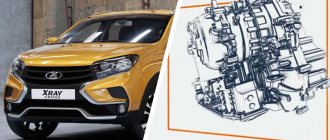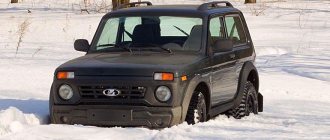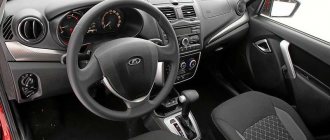In the fall, AVTOVAZ presented the updated Lada Vesta. Now this family is equipped with a Renault-Nissan alliance engine (1.6 l, 113 hp) and a continuously variable automatic transmission JF015E (hereinafter referred to as “variator” or CVT). We managed to find out how the car turned out during the test drive.
About the engine
Renault-Nissan HR16DE (1.6 l, 113 hp) is already familiar to us as H4M, because previously installed on Lada XRAY.
The main distinguishing features of this motor
:
- aluminum cylinder block;
- timing chain drive (no need to replace);
- automatic variable valve timing system, which improves filling of the engine cylinders in all operating modes;
- lack of hydraulic compensators (you will have to adjust the valves every 80 thousand km)
Specifications
:
- Maximum torque - 152Nm/4000rpm
- Maximum speed - 170 km/h
- Acceleration to 100 km/h - 12.2 seconds
- Fuel consumption in the combined cycle - 7.4 l/100km
The HR16DE/H4M engine is also installed on foreign cars: Nissan Note, Nissan Tiida, Nissan Qashqai, Nissan Sentra, Nissan Juke, etc. It has proven itself well among the owners of these cars and is an average engine.
Read more about this motor here.
Motor 21129
It was with this version of the gasoline engine that AvtoVAZ presented the first Vesta six years ago. Here are some of its characteristics:
- fuel - gasoline;
- volume – 1.6 liters;
- power – 106 forces;
- torque – 148 Nm.
Today, such a motor is paired only with a manual transmission with five forward gears. But the robot boxes were left only for the Grant model. Many compare the 21129 motor with the 21127 motor, which is equipped with some Grants, some even come to the conclusion that this is the same engine, but despite the fact that they have a lot in common, 21129 has a number of modifications that cannot be ignored:
- modernized lubrication system;
- the oil sump received a larger volume and an aluminum design (in 127 there is a steel one);
- another option for the oil intake;
- For installation on vehicles on the B0 platform (Largus, XRAY and Vesta), the support fastening system has been redesigned.
To accelerate Vesta to hundreds, the engine will need a little more than 11 seconds. The maximum speed it will show is 182 kilometers per hour. And, if you believe the passport data, the fuel consumption of Vesta in this modification will be approximately:
- 9.3 liters in the city;
- 5.5 liters on the highway;
- about 6.9 liters with the combined version.
This engine is very popular not only in Russia, but also in the CIS countries. The whole point is in its comparative primitiveness; the engine, by modern standards, is technically very simple. Which makes its maintenance a simple and cheap process.
At the same time, it is very difficult to call it unreliable. Provided proper and timely maintenance, it will not cause any serious problems to the user, of course, if you use the car adequately and adhere to the basic recommendations of the manufacturer.
This engine is the best solution for a simple Vesta in a sedan. Its power is quite enough for the average user, and reliability and maintainability fully compensate for what the 1.8 liter engine can offer, and allow us to talk about a longer resource.
About the variator
According to this site, the upgraded JF015E variator replaced the JF011E. The constructive idea is fundamentally different from its predecessor. The JF015E also has a torque converter that softens the load on the shafts, a planetary gear for reverse, but the main feature is two forward stages and three clutch packages: Direct No. 1 (Low), - No. 2 (High) and Reverse. This design made it possible to reduce the cone, increasing the gear ratio to a record 1:7.3 using two forward gears. Thus, this Jatco transmission can be called a two-speed CVT.
Reviews Lada Vesta SV Cross AMT
There are a large number of reviews of the AMT Lada Vesta SV Cross on the Internet. All reviews are different, but for the most part the robot on Vesta is a problem-free unit. Although there are also people who are less fortunate. Basically, they spread the main negativity on the Internet. I chose the first 3 reviews I came across about the Lada Vesta robot:
1. Alexander, Orsk
So, the robot is on the Lada Vesta Cross. I quite liked it. Anything is better than a stick. The most unusual thing for me was that you need to control the gear shift with the gas pedal. If you press the gas pedal harder, the speed switches to lower. For example, you are driving 40 km/h in 3rd gear and want to overtake someone, then you press the gas harder and the gear changes to second.
Switching to the next speed occurs by slightly releasing the gas pedal. For example, you press the pedal to the floor, the car takes off, the revolutions increase, for example, to 3.5 thousand, then you release the gas and the gear switches to second. Something like this. In general, this robot is quite a suitable topic. But you have to get used to switching so as not to get stuck on the road. In terms of reliability, I can’t say anything yet, since I’ve been driving the car for two months. During this time nothing broke.
How Vesta drives with a CVT
During the test drive of the Lada Vesta with a CVT, the following features
:
- There is a creeping mode (in “D” mode, the car itself begins to move smoothly when the brake pedal is released).
- During acceleration, there is an imitation of gear shifting (during normal driving, shifting occurs at 3500 - 4000 rpm, at full throttle - after 5000 rpm).
- There is no monotonous howl of the engine during acceleration, which many owners of cars with a CVT do not like.
- “Shifting gears” occurs without the slightest jerk.
- In manual shift mode "M" there are 6 virtual gears.
- In manual mode, the virtual gear is automatically reset to 1st when stopped.
- In manual mode, the virtual gear will automatically shift at 5500 rpm (500-800 rpm higher than in "D" mode).
- Acceleration of the Lada Vesta SW Cross to 100 km/h with one passenger and a full trunk takes 16 seconds, without a passenger - 13.4 seconds (according to the passport 12.2 seconds).
- Acceleration of the Lada Vesta Cross sedan to 100 km/h was 12.7 seconds in one direction, 13.7 in the opposite direction (11.3 seconds according to the passport).
- Fuel consumption during fairly active mountain tests did not exceed 10.3 l/100km.
- The CVT settings keep the engine speed low, which allows the engine to be quieter than other transmissions (at 120 km/h your tachometer will read 2000 rpm).
- With a sharp start, a slight delay is felt before the start of movement.
- The engine braking capabilities of the car are very limited; there is no noticeable deceleration.
- Due to the appearance of new universal joints of the same length, now during acceleration, especially on poor surfaces, the steering wheel no longer breaks out of your hands, and there is more stability during emergency braking.
- Off the asphalt, the car feels very insecure (the car has difficulty crawling even on a grassy slope with a soft top layer, not to mention driving on a liquefied primer or slippery gravel).
- It is better to overcome steep climbs by walking. If you stop on such a hill, the variator sometimes rebels - when starting from a standstill, it releases the clutch and refuses to go further.
- The overtaking margin at speeds above 120 km/h is not enough, especially on mountain roads. On the plains the situation is better, but not globally. Even in manual mode it feels like you're driving in ECO mode.
In general, everything is simple, clear and practical. For the city, Vesta with a CVT is enough, but outside the asphalt the car feels very insecure. Have you ever driven a Lada Vesta with a CVT? What feedback and impressions can you leave?
Some features were taken from test drive data from wheels.ru and artemspec.
Lada Vesta SV Cross AMT - how did it appear?
The AMT on the Lada Vesta SV is a unit already familiar to us, which has already appeared on other domestic models - Lada Priora, Granta, Kalina, X-ray. At first there were rumors that this same robot was developed by engineers from Renault-Nissan, but later these rumors were refuted. The AMT Lada Vesta SV Cross itself is AvtoVAZ’s own development.
In recent 2015, under the leadership of Vladimir Petunin, the first serial robot was developed. The basis was the usual 5-speed VAZ manual transmission 2180, which is already familiar to everyone. ZF electric actuators of German origin were used as the actuator. They are responsible for pressing the clutch and selecting gear for the driver. A shaft speed sensor also appeared at the gearbox. All together gave a robotic gearbox with the VAZ-2182 index:
Gear shift actuator for Lada Vesta SV Cross AMT
The actuator mechanism for selecting and switching speeds on the AMT Lada Vesta SV Cross looks like this:
1 — Gear selection drive 2 — Electric motor 3 — Gear selection drive 4 — Electric motor 5 — Gear selection rod
Actuators (electric motors) are used from German ZF.
Prices
The version with a CVT will be 50 thousand more expensive than the version with a VAZ-21179 engine and manual transmission. With the launch of the CVT version, all trim levels have been updated:
- The most affordable version is the 1.6 sedan (113 hp), AT Jatco, Classic + Start Plus - 736,900 rubles.
- The maximum cost for Lada Vesta SW Cross 1.6 (113 hp), AT Jatco, Luxe + Prestige is 982,900 rubles.
Two problems with the JF015E variator
The Jatco JF015E model has two problem areas - the sun gear and the input shaft bearing. The “Sun” here is quite fragile, the weld is not reliable enough, there are cases where even on cars with a mileage of 5-10 thousand km the gear was completely destroyed, which leads to difficulties in operating the car. You can understand that this particular part has failed by the following characteristic symptom of a breakdown: the car moves either only forward or only backward. You can install a reinforced part at a service station, but it is quite expensive.
Another weak point is the input shaft bearing. The bearing is quite weak, it is destroyed quite quickly, especially if the car enthusiast prefers an aggressive driving style. The main sign of wear of a part, as mentioned above, is extraneous noise in the transmission when switching to neutral or parking. At high speeds the annoying noise appears again. After the latest modernization of the Jatco JF015E, which AvtoVAZ carried out specifically for the Lada Vesta car, the variator was equipped with a new roller bearing, which, although it does not completely eliminate breakdown, at least seriously eliminates it.
How to extend the life of Jatco JF015E
In general, if we consider the issue of the service life of Jatco CVTs globally, then it is no less than the service life of modern multi-stage automatic transmissions. Yes, there are some design flaws (weak sun gear weld, unreliable shaft bearing), but with competent maintenance and proper attitude towards the car, many problems can really be avoided. The basis of the gearbox is transmission fluid, which should be changed in strict accordance with the period stated by the manufacturer.
Jatco recommends changing the oil at least every 30-40 thousand km. While maintenance can be slightly delayed on new cars, this should not be done on older used cars. The metal “powder” formed during operation of the unit can cause irreparable damage to the main and expensive CVT mechanisms. Replacing ATF must be accompanied by installing original filters. Violation of the regulations leads to early failure of the oil pump pressure reducing valve: scratches remain on it after contact with metal shavings, which leads to loss of tightness. As a result, the oil pressure in the system decreases, the transmission malfunctions and the beginning of increased wear of all parts and components.
CVT selector on Lada Vesta
CVT Jatco JF015E on Lada cars
edit this post











